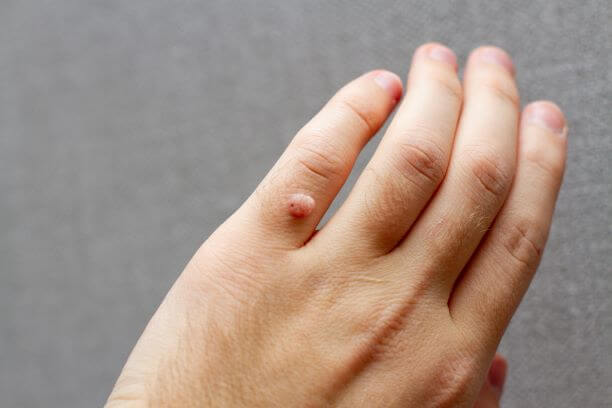During October, we’re all looking for great ways to make our Halloween costumes or our children’s a little more frightening. When it comes to witches, adding a huge wart or two…or ten gives the costume an extra layer of fright. If your wart is naturally occurring and not a part of your costume, however, you may already be feeling a little scared. The good news is, this skin condition is extremely common, easy to treat, and not altogether very scary. In this blog, Dr. Kathleen Ellison of U.S. Dermatology Partners in Fairfax, Virginia talks through answers to some of the questions dermatologists hear most often about warts.
What are Warts?
Warts are non-cancerous growths on the skin. There are many types of warts that are differentiated based on their appearance and the part of the body where they develop, but all warts are caused by human papillomavirus (HPV). Many people think of HPV as a sexually transmitted infection (STI). While some strains of HPV do lead to an STI, there are more than 100 different types of HPV. The infection from HPV causes warts to develop by triggering excessive skin cell growth. These small, fleshy skin growths are benign, but warts can be unsightly, irritating, or painful if they develop in awkward locations or grow very large.
According to Dr. Ellison, “While warts are typically harmless, they are contagious just like other viral infections, so you should take care to avoid allowing others to come into direct contact with your wart or any clothing or other items that have come into contact with the wart.”
Are there Different Kinds of Warts?
All warts are caused by infections associated with HPV, but they are given different names based on their appearance and the locations where they develop. Below, you’ll find the basic descriptions of the types of warts we see most often:
- Vurruca vulgaris – Also called common warts. This type of wart is often found on the hands, knees, and elbows. They look like flesh-colored, raised bumps on the skin. You may notice small darker-colored or black dots within the wart. These are sometimes called “seed warts,” but they are actually blood vessels.
- Plantar warts – This type of wart develops on the soles of the feet. While common warts create small, fleshy, protruding growths, plantar warts tend to be flat, thick skin growths. Patients with plantar warts typically develop a cluster of warts. Individuals with plantar warts often describe feeling like they’re walking on pebbles. People develop plantar warts due to HPV exposure from walking barefoot when using public showers, pools, gyms, or just walking outdoors without shoes on.
- Mosaic warts – A specific type of plantar wart that might grow in larger clusters. It forms more deeply into the foot, and they are often more difficult to treat.
- Flat warts – As the name implies, these warts are smooth and flat. They develop in large clusters of between 20 and 100 warts. They appear on the face, hands, neck, and other areas that frequently receive sun exposure. Men may develop flat warts in their beards, and women may develop them on their legs.
- Filiform warts – This is the “witchiest” type of wart. Filiform warts have a texture like brush bristles, and they often grow on the face around the eyes, nose, or mouth. This type of wart can grow very quickly.
- Periungual warts – This type of wart grows around fingernails and toenails. Because they may spread beneath the nails, it can be difficult to treat this type of wart at home, and they will often require professional treatment.
- Genital warts – Less than half of all strains of HPV develop in the genital area, and researchers predict that just two strains cause the bulk of genital warts. While most warts are benign, non-cancerous, genital warts can actually be a precursor for cervical cancer and other types of cancer, so it’s important to have genital warts checked by a medical professional.
What are the Symptoms of Warts?
The skin growth itself is the most common symptom, and warts have slightly different appearances and side effects based on their types and locations. Some common symptoms of warts include:
- A flesh-colored growth with a texture like cauliflower
- A cluster of flat growths
- Fibrous or bristle-like growths
- Dark or black dots within the main growth
- Itching
- Pain or pressure
- Tightness
What Causes Warts?
According to Dr. Ellison, “Dermatologists know that warts develop in response to exposure to human papillomavirus, but we’re still not sure why some people get warts frequently and others never have one, even if they have similar habits or are exposed to the same types of warts.” While we can’t be sure why certain people develop warts after HPV exposure and others don’t, some factors seem to increase risk, including:
- Weakened immune system
- Damaged, dry, or cracked skin
- Poorly managed chronic skin conditions like eczema and psoriasis
- Direct contact with people who have warts or with clothing and surfaces that have had direct contact with warts
- Children and teens may be more likely to develop warts because they haven’t developed immune system defenses like adults
Why are Warts Associated with Witches & Frogs?
It’s that time of year, so if your kids have heard that only witches have warts or that you get warts by touching frogs, we have some good news for you. That’s not true! The skin of frogs and toads may look like it’s covered in warts, but that’s just their skin. You can touch as many frogs as you’d like, or kiss all the toad princes this Halloween, but you won’t be at risk for developing warts. However, if you touch a human who has warts, you may develop a few of your own, so avoid contact with other people who have warts.
Another common Halloween-centric story about warts is that only witches have them. In fact, during the Salem witch trials, warts were called the devil’s mark and were considered to be an effect of engaging in witchcraft. These superstitions may seem harmless by modern standards, but they were very dangerous in the 17th century when engaging in magical rights carried a death sentence. Today, we know that warts develop as a result of exposure to HPV – not magic. It’s safe to say, warts are fun costume additions, but they’re not really a sign that someone you know is a witch.
What Are My Options for Treating Warts?
Like other viral infections, there is no cure for HPV. However, most warts either clear up on their own or are easily treated at home. In fact, as Dr. Ellison says, “Many patients don’t even need treatment for warts. If they’re not bothering the patient or they’re not in an obvious location, leaving them to clear up on their own can be just as effective as any treatment. However, because warts are contagious, you should follow your dermatologist’s instructions to prevent the spread of warts to other people or to other parts of the body.”
Dermatologists may recommend treating warts if they are painful, spreading, growing quickly, bleeding, or causing other concerns. When treatment for warts is recommended, it usually involves using acidic ingredients, heat, or cold to damage skin cells that make up the visible parts of the wart and trigger the immune system to attack and destroy the wart from the inside out. In rare cases, we may need to surgically remove the wart. Typically, your dermatologist will recommend one of the following wart removal options:
- At home, topical treatment – These products are available both over the counter and by prescription. The active ingredient is usually a high dose of salicylic acid, which is a common ingredient in many skin care products. The acid eats away the visible parts of the wart while the injury to the skin triggers the immune system to respond and attack the virus that caused the wart.
- Cantharidin – This topical treatment is applied by the dermatologist and causes a blister to form around the wart. It lifts the wart away from the body and encases the cells within the blister. After the blister dries out, the wart and blister will usually fall away.
- In-office cryotherapy – Extreme cold, usually liquid nitrogen, is used to damage the wart cells. This causes the same response as topical creams, freezing away the wart and causing the body to attack the virus.
- In-office heat therapy – Using either a laser or electrical current, heat destroys the wart and triggers the immune system like topical creams and cryotherapy.
- Biopsy and removal – For genital warts, which are often linked to cervical cancer and other forms of cancer, we may need to partner with a gynecologist, oncologist, or other medical professionals to ensure the safe removal of the wart and complete testing of the cells (biopsy) to check for cancer.
- Surgical removal – Using a scalpel to excise the wart. In most cases, your dermatologist will surgically remove a small part of the wart to ensure there is no cancer or other concerning underlying issues. Otherwise, surgical removal is only recommended if warts are very large or growing deep below the skin.
- Cancer medicines – While most warts are benign, studies show that the way wart cells replicate is similar to cancer cell growth. For this reason, cancer medicines like 5-Fluorouracil and Bleomycin may be used to prevent wart cell growth, especially if removal has not been effective in preventing the spread of warts.
- Immunotherapy – If removal hasn’t worked and you have numerous, fast-growing warts, your dermatologist may use immunotherapy to boost your immune response, so you’re able to fight the underlying virus.
Can Warts be Prevented?
It’s difficult to prevent the development of warts altogether, but since warts are contagious, taking steps to avoid contact with people who have warts, as well as their clothing or other items that have been in contact with warts, is the easiest way to reduce your risk for developing warts. Those who have received the HPV vaccine may also be less likely to develop warts. Additional steps you can take to prevent the development of warts and avoid spreading them to other people or other parts of the body include:
- Wear shoes in public showers, pools, saunas, changing rooms, and gyms
- Don’t touch or scratch your warts other than to apply topical treatments, and wash hands thoroughly after touching warts
- Keep warts covered
- Don’t shave the area directly over a wart
- Don’t share towels, linens, clothing, nail clippers, pumice stones, or other items
- Immediately clean, disinfect, and cover all scrapes or scratches
- Avoid excessive dryness or cracked skin by moisturizing regularly
- Don’t bite fingernails and take care when grooming your nails
- Use barrier birth control methods to avoid contracting genital warts
Do Home Treatments for Warts Actually Work?
According to Dr. Ellison, “In most cases, we don’t recommend at-home remedies for skin conditions, but warts are so common that there really are some good over the counter treatments available to clear them up. If you’ve never had a wart, talk to your dermatologist first, but if you develop warts often, there’s no harm in treating them at home.”
Don’t Let Warts Scare You This Halloween – Visit U.S. Dermatology Partners Today!
If you have warts that are bothering you, give the U.S. Dermatology Partners team a call. We’re here to help you with all of your skin care needs. You can even get started by requesting an appointment online, using our simple scheduling request form. We look forward to hearing from you.
Find a location near me
or


